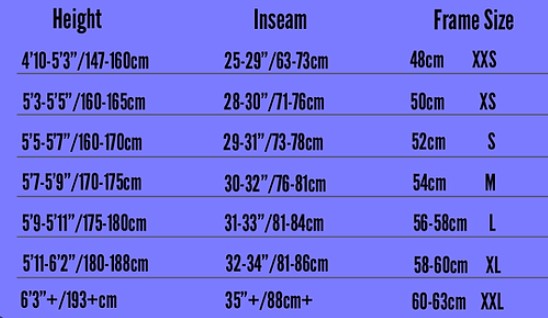Finding the right bike size is key for a comfy and enjoyable ride. A bike that is too big or too small can lead to pain, fatigue, and even injuries. Therefore, consulting a bike size chart is a key step before purchasing a new bike. This blog post aims to provide comprehensive insights into bike size charts, covering aspects such as how to read them, factors to consider when choosing a bike size, a detailed bike size chart for adults and children, and tips for finding the perfect bike fit.
How to Read a Bike Size Chart

Bike size charts are super important tools for selecting a bicycle that best suits your body proportions and riding preferences. Understanding these charts can be the key to a comfortable and efficient riding experience. Here’s a comprehensive guide to deciphering bike size charts:
Essential Measurements: Frame Size and Wheel Size
Frame Size:
- Represents the distance between the center of the bottom bracket (where the pedals connect to the cranks) and the top of the seat tube.
- Commonly measured in inches or centimeters.
- Larger numbers indicate a bigger frame.
Wheel Size:
- Refers to the diameter of the bike’s wheels.
- Also measured in inches, varying from 12 inches for children’s bikes to 29 inches for adult mountain bikes.
- Larger wheels are typically found on bikes designed for older or taller riders.
Matching Your Height to Frame Size
Bike size charts categorize recommended frame and wheel sizes based on the rider’s height. For example, a person who is 5’6″ to 5’10” tall might be best suited to a 17-inch frame with 26-inch wheels.
Factors Influencing Bike Size Selection
- Inside Leg Measurement:
- Crucial for determining saddle height and overall comfort.
- A shorter inside leg might require a smaller frame for a lower saddle position.
- Riding Style:
- Mountain biking often calls for larger frames for better stability on rough terrain.
- Road cyclists might lean towards smaller frames for a more aerodynamic position.
- Personal Preferences:
- Some riders prefer an upright position, while others opt for a more forward-leaning stance.
- Testing different bike sizes can help pinpoint your preferred riding posture.
Seeking Professional Guidance
For those uncertain about their bike size or specific fit needs, consulting with a professional at a bike shop is recommended. Their expertise can guide you to a bike that aligns perfectly with your individual needs and riding style.
Factors to Consider When Choosing a Bike Size
When selecting a bike size, consider these factors:
- Riding Style: Your riding style influences the choice of bike size. For off-road riding, a bike with a larger frame and wheel size is preferred for better clearance over obstacles.

- Inseam Measurement: Your inseam, the distance from your inner thigh to the ground, is super important in determining the right seat height.
- Personal Preference: The best bike size is often found through trial and error. Test different bikes to see which one feels the most comfortable.
A Comprehensive Bike Size Chart for Adults and Children
Bike Size Chart for Adults
| Height | Frame Size (Inches) | Wheel Size (Inches) |
|---|---|---|
| 4’11” – 5’1″ | 14 | 26 |
| 5’2″ – 5’4″ | 15 | 26 |
| 5’5″ – 5’7″ | 16 | 26 |
| 5’8″ – 5’10” | 17 | 26 |
| 5’11” – 6’1″ | 18 | 26 |
| 6’2″ – 6’4″ | 19 | 26 |
| 6’5″ and up | 20 | 26 |
This chart is a general guide. Note that some brands may have different sizing recommendations.
Bike Size Chart for Children
| Height | Frame Size (Inches) | Wheel Size (Inches) |
|---|---|---|
| 3’5″ – 3’9″ | 12 | 16 |
| 3’10” – 4’2″ | 14 | 16 |
| 4’3″ – 4’5″ | 16 | 20 |
| 4’6″ – 4’8″ | 18 | 20 |
| 4’9″ and up | 20 | 24 |
Tips for Finding the Perfect Bike Fit
Finding the perfect bike fit involves several steps:
- Seat Position: Sit on the bike with your feet flat on the ground. Your knees should be slightly bent for the correct seat height.
- Handlebar Reach: While seated, reach for the handlebars. Your elbows should be slightly bent for a comfortable reach.
- Seat Height Check: Have a friend check your seat height. The ideal position is when your leg is almost fully extended with your heel on the pedal.
- Test Ride: Always take the bike for a test ride to ensure comfort and control.
Conclusion
Choosing the right bike size is fundamental for a pleasant and safe cycling experience. By utilizing a bike size chart and considering factors like your height, inseam, riding style, and personal preference, you can find a bike that fits you perfectly. Remember to make necessary adjustments for an even better fit. For more information and resources on biking, visit Best Bike Parks, your ultimate destination for all things cycling. Enjoy your ride!







